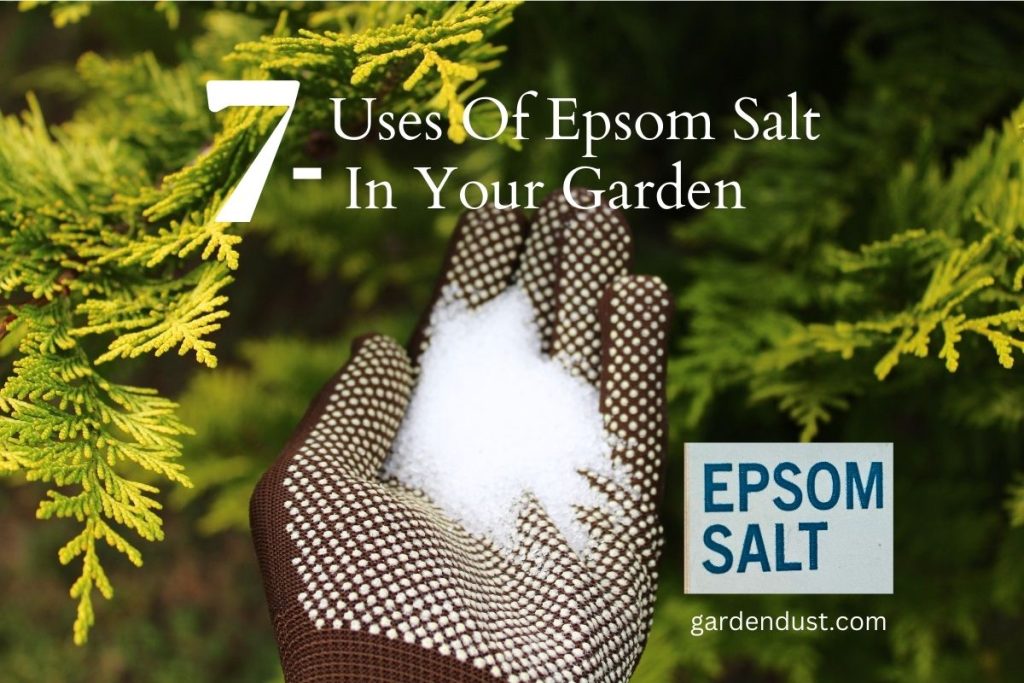Gardening enthusiasts and seasoned horticulturists alike are constantly seeking natural and cost-effective ways to enhance the health and productivity of their plants. One such versatile and time-tested solution is Epsom salt, a mineral compound consisting of magnesium and sulfate. Originally discovered in the town of Epsom in England, Epsom salt has found its place in gardens around the world due to its numerous benefits for plants and soil. In this comprehensive guide, we will explore 7 uses of Epsom salt in your garden and how it can contribute to the overall well-being of your plants. Let’s see…
1. Boosting Nutrient Absorption
One of the primary benefits of Epsom salt in the garden is its ability to enhance nutrient absorption in plants. Magnesium, a key component of Epsom salt, plays a crucial role in photosynthesis, the process by which plants convert sunlight into energy. By supplying magnesium to your plants, you promote chlorophyll production, resulting in healthier and more robust foliage.
To utilize Epsom salt for this purpose, dissolve 1-2 tablespoons of Epsom salt in a gallon of water and use it to water your plants. This solution can be applied to both the soil and the foliage, allowing the plant to absorb the magnesium and sulfate through its roots and leaves.
2. Improved Seed Germination
Epsom salt can be a valuable ally when starting seeds or transplanting seedlings. The magnesium content in Epsom salt aids in the germination process by promoting seed vigor and strengthening young plants. To give your seeds a head start, mix a small amount of Epsom salt with the soil in your seed trays or sprinkle a pinch at the base of each planting hole when transplanting seedlings.
3. Enhanced Flowering and Fruiting
For gardeners seeking to maximize flower and fruit production, Epsom salt can be a secret weapon. The magnesium in Epsom salt encourages the development of blooms and helps in the formation of fruit. Regular applications of Epsom salt during the growing season can lead to more abundant and vibrant flowers, as well as larger and tastier fruits.
Create a flowering boost spray by dissolving 2 tablespoons of Epsom salt in a gallon of water. Apply this solution to your flowering plants once a month during the growing season to promote healthy flowering and fruiting.
READ ALSO:-10 Reason -Use Cinnamon In Your Garden
4. Soil Structure Improvement
Epsom salt not only benefits plants directly but also contributes to soil health and structure. The sulfate component in Epsom salt aids in nutrient absorption and improves the overall texture of the soil. In clayey soils, Epsom salt can help break up compacted soil, allowing for better water drainage and root development.
To enhance your soil structure, incorporate Epsom salt into the soil before planting or apply it as a top dressing. Aim for 1-2 tablespoons per square foot, mixing it thoroughly with the soil.
5. Combatting Magnesium Deficiency
Plants, particularly vegetables like tomatoes and peppers, may suffer from magnesium deficiency, leading to yellowing leaves and poor fruit development. Epsom salt is a quick and effective remedy for this issue. Applying Epsom salt to the affected plants provides a readily available source of magnesium, correcting the deficiency and promoting healthier growth.
To address magnesium deficiency, dissolve 2-3 tablespoons of Epsom salt in a gallon of water and apply it to the affected plants. Repeat the application every 2-4 weeks until symptoms improve.
6. Deterrent for Pests
Surprisingly, Epsom salt can also play a role in pest control. While it won’t eradicate all garden pests, it can help deter certain insects, such as slugs and snails. Sprinkle Epsom salt around the base of plants or create a barrier in problem areas to discourage these pests. Additionally, the magnesium content can contribute to plant resilience, making them less susceptible to pest damage.
7. Rejuvenating Houseplants
Indoor plants can also benefit from the application of Epsom salt. Over time, potted plants may experience a build-up of salts in the soil, leading to nutrient deficiencies and poor growth. To rejuvenate your houseplants, mix a tablespoon of Epsom salt into the soil during repotting or dissolve it in water and use it to water your indoor plants.
Epsom salt stands as a versatile and valuable asset in the garden, offering a range of benefits from enhancing nutrient absorption to improving soil structure. As with any gardening practice, moderation is key, and it’s important to observe your plants’ response to Epsom salt applications. When used judiciously, Epsom salt can be a cost-effective and natural solution to promote the health and vitality of your garden. Experiment with the various applications discussed in this guide, and you may find Epsom salt becoming an indispensable tool in your gardening arsenal. Happy Gardening…







